Inside\Within is a constantly updating web archive devoted to physically exploring the creative spaces of Chicago's emerging and established artists.
Support for this project was provided by The Propeller Fund, a joint administrated grant from Threewalls and Gallery 400 at The University of Illinois at Chicago.

Search using the field below:
Or display posts from these tags:
3D printing 3D scanning 65 Grand 7/3 Split 8550 Ohio 96 ACRES A+D Gallery ACRE animation Art Institute of Chicago Arts Incubator Arts of Life audio blogging Brain Frame CAKE Carrie Secrist Gallery casting ceramics Chicago Artist Writers Chicago Artists Coalition Chicago Cultural Center Cleve Carney Art Gallery Clutch Gallery Cobalt Studio Coco River Fudge Street collage collection Columbia College Chicago Comfort Station comics conceptual art Contemporary Art Daily Corbett vs. Dempsey Creative Capital DCASE DePaul University design Devening Projects digital art Dock 6 Document drawing Duke University dye Elmhurst Art Museum EXPO Chicago Faber&Faber fashion fiber Field Museum film found objects GIF Graham Foundation graphic design Harold Washington College Hatch Hyde Park Art Center illustration Image File Press Imagists Important Projects ink installation International Museum of Surgical Science Iran Jane-Addams Hull House Museum jewelry Joan Flasch Artist's Book Collection Johalla Projects Julius Caesar Kavi Gupta Links Hall Lloyd Dobler LVL3 Mana Contemporary metalwork Millennium Park Minneapolis College of Art and Design Monique Meloche Museum of Contemporary Art Chicago (MCA) Museum of Contemporary Art Detroit (MOCAD) Museum of Contemporary Photography (MoCP) National Museum of Mexican Art (NMMA) National Resources Defense Council New Capital Northeastern Illinois University Northwestern University Ox-Bow painting paper mache Peanut Gallery peformance Peregrine Program performance photography PLHK poetry portraiture printmaking public art Public Collectors publications Renaissance Society risograph rituals Roman Susan Roots&Culture SAIC screen printing sculpture Sector 2337 Shane Campbell Silver Galleon Press Skowhegan Slow Smart Museum Soberscove Press social practice South of the Tracks Storefront SUB-MISSION Tan n' Loose Temporary Services Terrain Terrain Biennial text-based textile textiles The Banff Centre The Bindery Projects The Cultural Center The Franklin The Hills The Luminary The Packing Plant The Poetry Foundation The Poor Farm The School of the Art Institute of Chicago (SAIC) Threewalls Tracers Trinity College Trubble Club University of Chicago University of Illinois at Chicago (UIC) University of South Florida at Tampa Valerie Carberry Vermont Studio Center video weaving Western Exhibitions wood carving woodwork Yellow Book Yollocalli Arts Reach zinesInside\Within is produced in Chicago, IL.
Get in touch:
contactinsidewithin@gmail.com
Ellen Nielsen’s Decorative Power
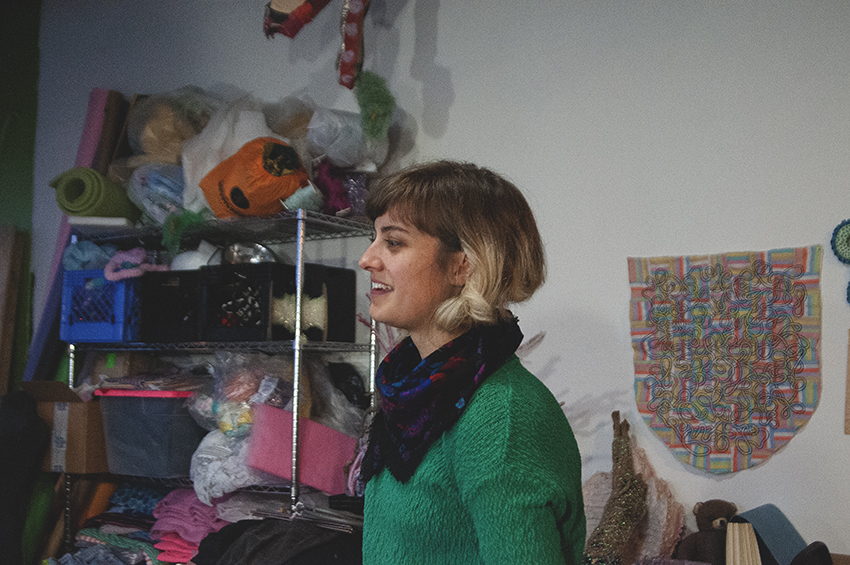
Ellen works from a studio inside of her apartment, surrounded by thread, fake flowers, and costumes made both for herself and other artists. Through staged acts she embodies decorative symbols and innocent icons, taking the form of a flower, bunny, or baby in order to highlight topics such as sexism and sexual objectification through stand-up comedy and strip routines. Interested in ornamentation and its potential for aggression, Ellen also produces sculptural work that is highly decorative, forming embroidered banners with complicated motifs and pom poms that aim to destroy corporate architecture.
I\W: How do you focus on ornamentation in your work?
EN: I’m interested in kitsch and decoration because they’re these seemingly innocuous, apparently meaningless, subjects that actually have a lot of cultural and emotional significance. I read Adolf Loos’ essay “Ornament and Crime” in a Design Theory class in undergrad, and I was really appalled by how misogynist and racist it was. In Austria in 1908, he was writing things like “Modern Man does not ornament his body like the degenerate native, Modern man is clean and pure . . . Modern man does not adorn himself like the frivolous woman.” I’m paraphrasing but not exaggerating. This essay is held up as one of the originating texts of Modern design. Loos believed that in order to progress as a society, “we” (meaning Europe) had to get rid of all culturally-specific decoration, as well as the labor that produced it. He clearly associates ornamentation with femininity and non-Western, non-white cultures, and then argues for its eradication. The political implications of this idea become clearer when you look at how it was embraced by totalitarian regimes like Nazi Germany and Fascist Italy, and currently, global corporate capitalism. Unornamented surfaces feel inhuman—or even anti-human—to me.
I moved to Chicago to go to grad school in 2009, and I remember feeling literally belittled by the sprawling grid-based structure of the city and all the minimal, corporate architecture. I started using decoration as a kind of a celebratory queer, feminist antidote to the city. I made giant pom poms out of acrylic yarn and a 8-foot-tall, upholstered paisley. I made a video called “Pombomb” where I attack the Aon Center (which is the headquarters of BP and formerly the Standard Oil Building) by repeatedly throwing on of my giant pom poms at it. I started thinking about how I could portray decorative subject matter like doilies and flowers in ways that made it seem powerful and aggressive.
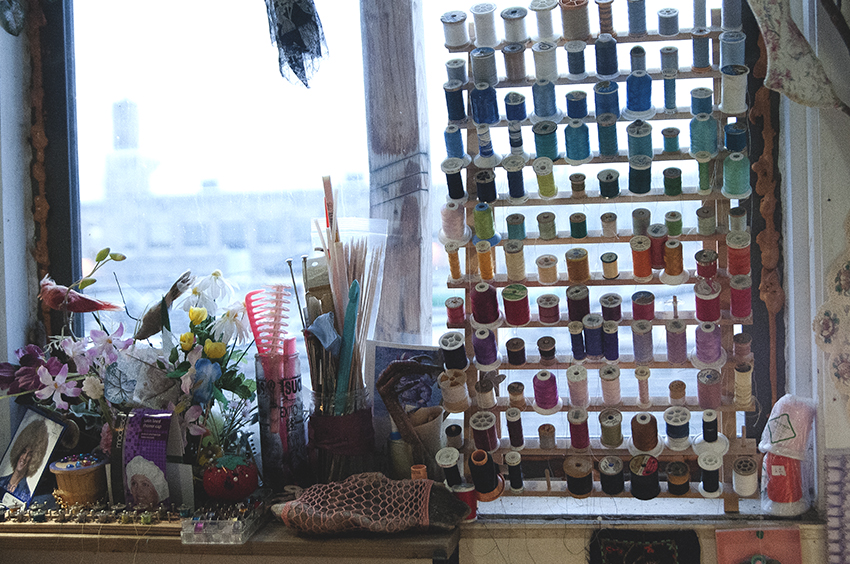
What is your interest in floral iconography?
I like that flowers are both an overused cliché and a super potent symbol of femininity, sexuality, and non-conformity. I’m interested in using subject matter that has to work for its meaning. Flowers are almost a cipher for “meaningless decoration,” and I like complicating that. In a lot of my work, decorative objects are given a kind of anima or agency. I made a stop-motion animation called “Fake is Forever,” where paper flowers scream and moan as they open. It’s conventionally pretty and unnerving at the same time.
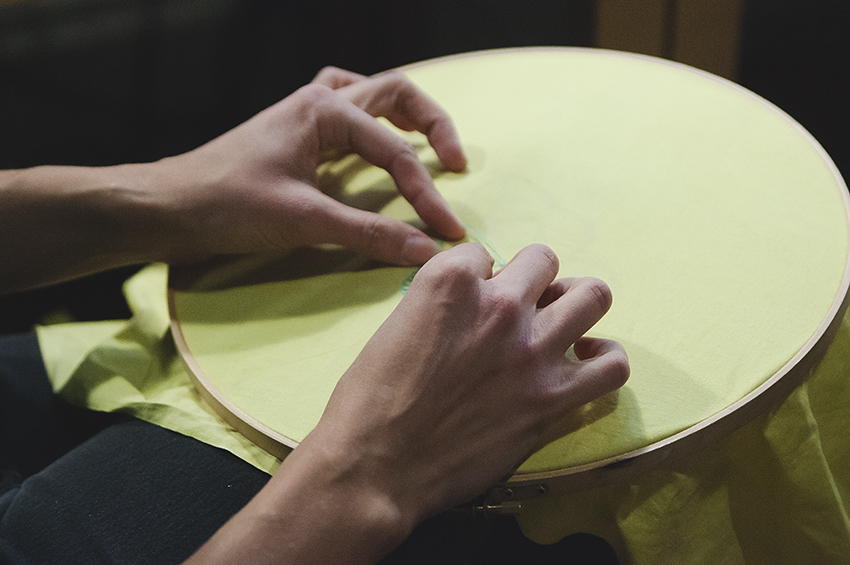
As a “Spooky Flower,” I perform an aggressive, non-sexy striptease to “Kiss From a Rose” by Seal in a multi-layered costume, complete with goth makeup and a daisy headdress. I also do stand-up comedy as a Spooky Butterfly. Last spring, I did an interactive installation at the MCA called “Flower Formal” where a cast of six flowers and one butterfly made paper corsages and danced to “Then He Kissed Me” by The Crystals. By literally embodying decorative subject matter, I’m able to humorously address serious topics like sexual objectification, romantic pain, and the alienation of workers. In my video, “Flower Office,” a group of secretarial daisies type, print, process, copy, file, and shred identical pieces of paper printed with a large flower wingding. It’s a joke about office environments and the absurdity of most bureaucratic labor, which is often feminized. It’s also about subverting capitalism through non-productivity, but the tone of the piece is light. Humor is important to me even when I’m making political work.
I’m interested in using subject matter that has to work for its meaning. Flowers are almost a cipher for “meaningless decoration,” and I like complicating that.
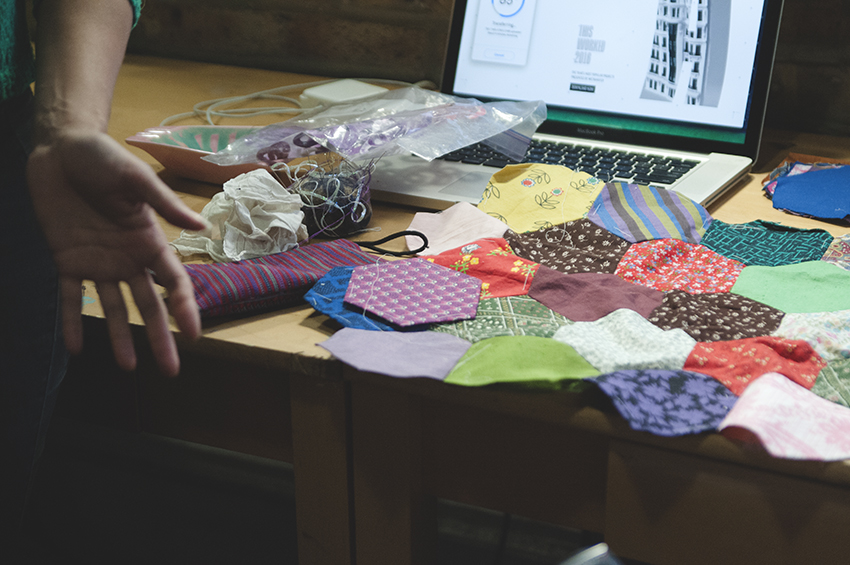
How have you been channeling your recent political frustrations in the studio?
I spent all winter hand-piecing a quilt, which could be seen as very non-political, but I felt like it was important for me to take a step back and meditate on what was happening in the world. Most quilt tops are machine-pieced and then the hand sewing happens when you quilt the layers together, but I made this one the inefficient, pre-industrial way. I spent hours and hours just sitting in my studio hand-sewing and absorbing as much information as I could via political podcasts, lectures, and audio books. This quilt is emphatically not intended to be an art piece— it’s going to go on my bed. It felt very affirming and optimistic to invest time in a beautiful, useful object that had absolutely nothing to do with my career. I think it was “craft therapy” in a way. It got me in the habit of sitting and sewing, and now I’m working on a series of embroidered shields and banners that I see as more explicitly conceptual. In this new work, I’m injecting the format of the medieval standard with irreproducibly complex, looping embroidered motifs. Unlike the banners that they reference, these pieces would be highly ineffective as political signals or symbols because they’re so complicated. I think of them as flags for the personal, collective, irrational, and chaotic.
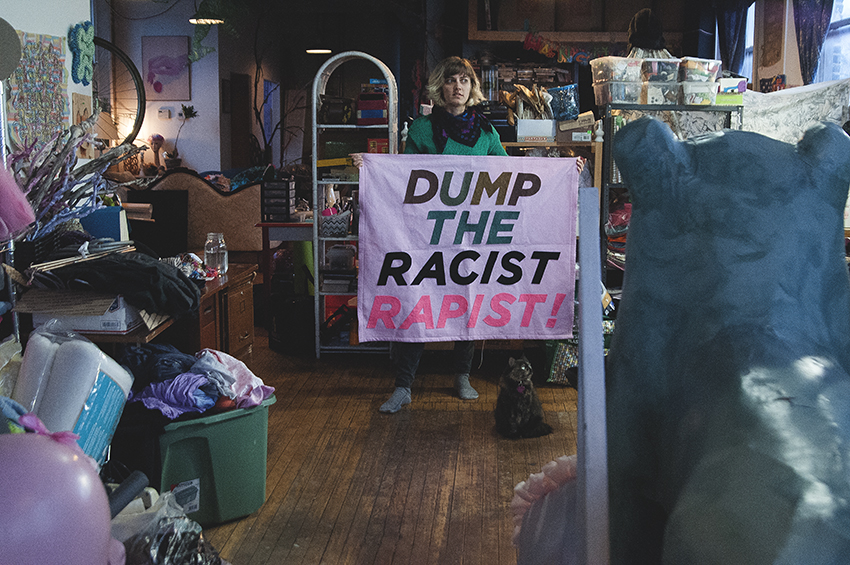
I’ve been seeing a lot of protest signs you have been creating recently for different political rallies. Do you consider the protest signs you create as a part of your practice?
I made a pink felt banner for the anti-Trump UIC rally that says, “DUMP THE RACIST RAPIST,” and I’ve used it about four or five times now. I like to be smiling and waving when I hold it. People are always commenting on the contrast between the soft materiality of the banner and the intensity of its message. In that way, I think it’s extremely related to my work, but I don’t see it as being actually part of my art practice. I have a lot of physical reality craft skills (like sewing, carpentry, upholstery, etc) that I use both in artistic and practical applications. Social media has flattened the distinction in some ways, because I’ll post pictures of a political banner I made for a protest next to a dress I made for a wedding next to a sculpture that I made for a gallery, but ultimately I want the artwork to be a little more conceptual than the dress and a little less didactic than the banner.
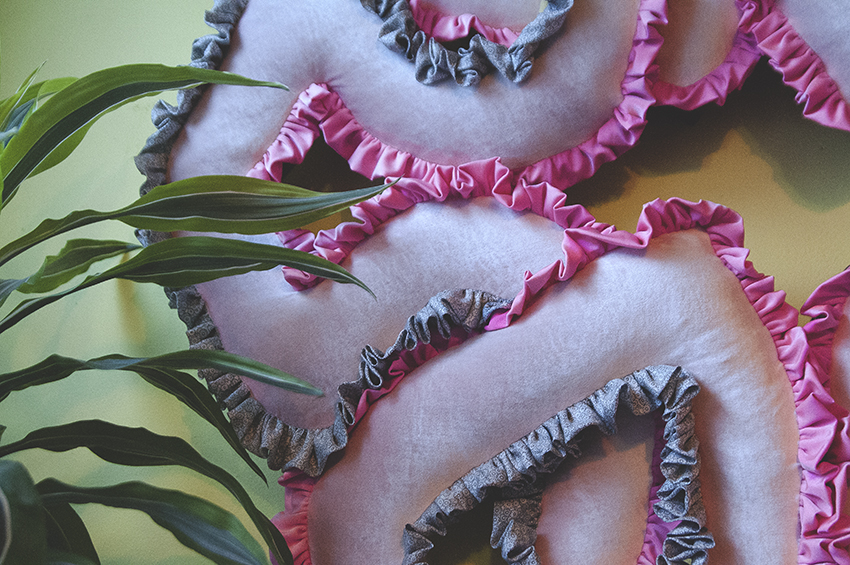
What are other ways that you are incorporating elements of ornamentation in your visual practice?
I’m very slowly accumulating a series of large-scale upholstered sculptures that are based on tiny lace and textile motifs. The first one I made was an 8-foot-tall black and dayglo paisley that I originally intended to illegally attach to a Mies Van Der Rohe building. I chickened out, because I didn’t want to get arrested, but I’m happy with it as a stand-alone piece. This body of work was inspired by an Edward Gorey book called “Les Passementeries Horribles,” in which larger-than-human-sized tassels and trimmings lurk about and stalk people in Victorian interiors. I really think of most of the objects I make as characters.
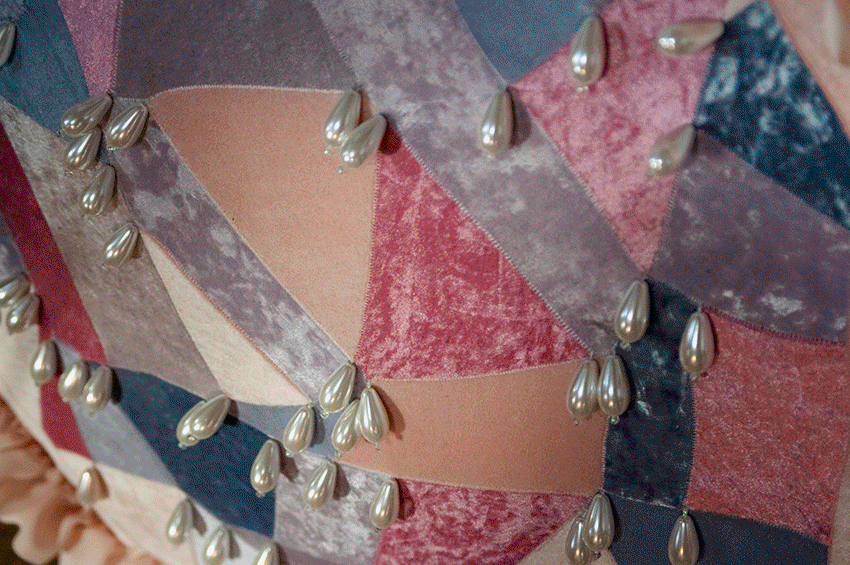
How did these material explorations lead to your work with performance?
I feel like I have always been working with performance. I was a children’s theater actor when I was a kid, and when I got out of undergrad at MICA, I worked at Centerstage, a large, regional theater in Baltimore, building props. Most of the technical skills I use to make my work were actually acquired at that job and not at art school. I was also a member of the Annex Theater, which started as a DIY performance collective operating out of a warehouse and is now an established, experimental outfit with its own building. The Annex people originally contacted me to make sets, props, and costumes, but I also started performing in the productions and directing. In 2009 with the Annex, I produced and directed a puppet musical of Harry Nilsson’s album “The Point” with a full band and 15 person cast. In 2012, I played Salome in the Annex rewrite of the Oscar Wilde play and went on a 12-city tour through the East Coast and Midwest. Now that I live in Chicago, I miss that collaborative theater environment, but I wonder if I would be making as much studio art if I hadn’t moved. My creative itch was getting so thoroughly scratched by making props and costumes that I didn’t feel super motivated to pursue my solo practice. I love working in theater, but most of my ideas seem to take the form of objects and images. I’m not a very narrative thinker. Even my performances are mostly costume and prop-based.
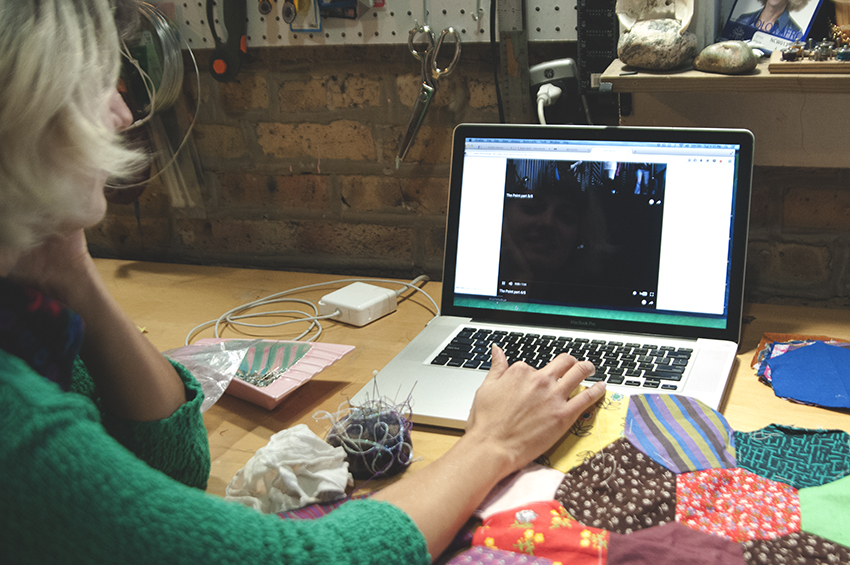
How are you incorporating costumes and props into your practice currently?
I also make custom costumes and props as a freelance job. I recently made a bodysuit for Sarah Squirm, who is a fantastic, up-and-coming stand up who hosts HELLTRAP NIGHTMARE at the Hideout. Her work is feminist, gross-out comedy / horror, and the bodysuit has hairy nipples and a giant bush. I’ve started making her a “visible woman” anatomical bodysuit that will have all of the organs on the outside.
In addition to the Spooky Flower and Spooky Butterfly performances, I perform as a BABBY in this horrible, oversize baby/bunny head I found at the Wasteshed. Actually Ellie Ray, who runs the Wasteshed, found it for me. I was at a thrift store, and I found this weird Precious Moments doll with a human face and bunny ears. I posted a picture of it on Facebook with the caption, “I need to perform as exactly this,” and Ellie sent me a message, “I have exactly this thing in the store right now!” It was totally serendipitous. I think it used to be a part of an Easter bunny costume or maybe a mascot, but it’s really horrifying. Like the Spooky Flower performance, BABBY is also a striptease with a 13-layer costume. I come out looking like a very zaftig lady in a long sleeve fleece robe and dance to an edited version of the Britney Spears song “Baby One More Time” as I remove layers. I don’t have the whole thing choreographed, but every costume element has an action that goes with it. For example, I have a leotard made from 6 curly pink clown wigs, and it looks great when I bounce in it. The final layer is a lace teddy with baby-bottle nipples and a crushed velvet thong with a merkin made from Easter grass. Like my other work, this performance is meant to be funny and somewhat dark. It’s a “joke” about the infantilization of women. I don’t consider these striptease performances to be burlesque, because the tone is not even slightly erotic. I’m inspired by the experimental drag performances by artists like Narcissister or The Voluptuous Horror of Karen Black. I’m interested in finding the absurdity in conventional ideas about gender and sexuality and pushing it to the extreme.



